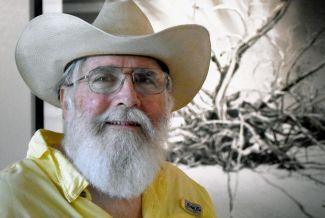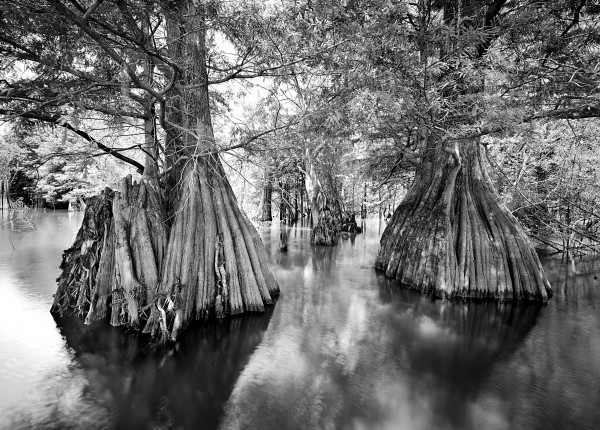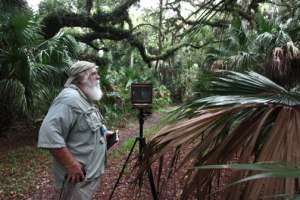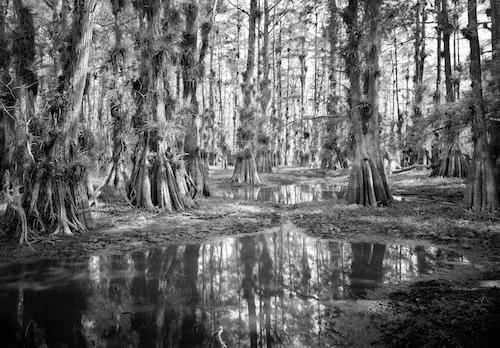» Clyde Butcher, Florida’s internationally celebrated black-and-white landscape film photographer, just opened a gallery at 55 South Boulevard of the Presidents in St. Armands Circle, a short hop over the Ringling Bridge from downtown Sarasota.
 The 1,200-square-foot space is a high-end departure for Butcher. His Venice gallery is isolated in an industrial park and includes a 2,000-square-foot darkroom. The gallery in Ochopee is roughly halfway between Naples and Miami on the Tamiami Trail, near the ranger station for Big Cypress National Preserve.
The 1,200-square-foot space is a high-end departure for Butcher. His Venice gallery is isolated in an industrial park and includes a 2,000-square-foot darkroom. The gallery in Ochopee is roughly halfway between Naples and Miami on the Tamiami Trail, near the ranger station for Big Cypress National Preserve.
What the galleries share are Butcher’s iconic and massive prints, some as large as 5-by-9 feet.
“What I’m trying to do is get people engaged in the photographs,” Butcher said in a telephone interview in 2014. “When I make my pictures large, you can't see them. You have to experience them.”
At the time, expectations for preserving Florida’s environment were sky-high after voters overwhelming approved Amendment 1 — the Florida Water and Land Conservation Initiative, which is not exactly going as planned.
Butcher’s environmental perspective — and some of his photos of Walton Ranch that were published with his permission — is revisited here ...
Florida ranchers seem to be a tolerant group. Their land supports vast populations of wildlife, including the rarest. A rich mixture of habitats protect water systems that serve millions. Developers want to buy it; activists want to save it; and the government wants to tax it.
“Florida ranchers have a lot of concerns today, particularly the individual,” said Clyde Butcher, the conservationist and landscape photographer.
There are nearly 1 million head of cattle in Florida and the industry pours roughly $2 billion into the economy, according to the state Department of Agriculture and Consumer Services. Six years ago more than 1.7 million head was part of a $4 billion ranching business.
 On Friday, three ranches in Sarasota and Manatee counties joined Florida Forever as part of the Myakka Ranchlands Project, which already includes Walton Ranch. Florida Forever offers 119 projects, representing 2,075,920 acres, including working ranches considered vital for ecosystems. And Amendment 1 is raising expectations.
On Friday, three ranches in Sarasota and Manatee counties joined Florida Forever as part of the Myakka Ranchlands Project, which already includes Walton Ranch. Florida Forever offers 119 projects, representing 2,075,920 acres, including working ranches considered vital for ecosystems. And Amendment 1 is raising expectations.
“When I was talking to the Waltons they were excited about getting some of their natural water flows back. They seem to be a very enlightened family,” Clyde Butcher said. “One of the things they said to me is the next crop, if we’re not careful, will be houses.”
Walton Ranch, a 3,800-acre rectangle in eastern Sarasota County, was purchased partly with Florida Forever money. A proposed eco-park and reserve is expected to open next year, part of a potential 110,000-acre wilderness corridor from Myakka River State Park to the RV Griffin Reserve.
Butcher and wife, Niki, were artists-in-residence in 2011 at the Conservation Foundation of the Gulf Coast, which helped arrange the Walton Ranch purchase by Sarasota County in 2010. Several popular photographs were taken during their visits to the ranch.
 “A lot of what I thought was impressive [about Walton Ranch] was the people,” Butcher said. “All the people who work the ranch seem to have the right attitude. That’s very important. Some corporations have these ranches, but most of the family ranches seem to be concerned about the land. Corporations are running the world now so it’s nice to have some sane people around.”
“A lot of what I thought was impressive [about Walton Ranch] was the people,” Butcher said. “All the people who work the ranch seem to have the right attitude. That’s very important. Some corporations have these ranches, but most of the family ranches seem to be concerned about the land. Corporations are running the world now so it’s nice to have some sane people around.”
Tom Gaskins' Place
The Butchers moved to Florida from California in 1980 after selling a commercial art business. Clyde was a shutter click from 40, idling artistically, he said.
For Butcher, the story has made the rounds, still twisted as a cypress.
“I didn’t see Florida for four years,” Butcher said. “I didn’t really start seeing it until 1984. When I was going to Orlando I went by Tom Gaskins’ place off [U.S.] 27, Fisheating Creek.”
Gaskins ran an iconic outpost called the Cypress Knee Museum. His trade was in gnarled cypress knees and swamp tours.
“I mean, I’m from California and I’d seen movies of gators and snakes and all that stuff,” Butcher said on the phone at his cottage in Big Cypress National Preserve. “I wasn’t going to get in the woods. And [Gaskins] had a boardwalk, which was actually a board-and-walk. And it got me into it. It gave me the same feeling as the Redwood Forest in California.
“I started seeing what Florida was. … And I keep learning more and more about Florida and its beauty because I get off the road.”
Don't Look Too Close
When Butcher goes on a shoot, his equipment can weigh 50 pounds. Six- to 10-minute film exposures provide panoramic prints as large as 5-by-8 feet.
 “What I’m trying to do is get people engaged in the photographs,” Butcher said. “Now, by the way I way photograph, and when I make my pictures large, you can’t see them. You have to experience them. … if you stand very close to one of my pictures, you have to scan it. And that gives you the feeling of being there.
“What I’m trying to do is get people engaged in the photographs,” Butcher said. “Now, by the way I way photograph, and when I make my pictures large, you can’t see them. You have to experience them. … if you stand very close to one of my pictures, you have to scan it. And that gives you the feeling of being there.
“And that’s what I’m trying to do: put people in places that most people wouldn’t go, and [give] them an idea of what the feeling of that landscape is.”
Clyde Butcher's galleries are in a Venice industrial park, which houses his studio, and in the heart of the Everglades.
“One of the things about ranches is there’s not a lot of profit margin in doing ranching anymore, particularly family ranches,” Butcher said. “Somehow we need to get them more tax benefits so they don’t have to sell.”
Butcher has been honored widely and frequently for conservation efforts. He said the motivation for his work is conservation.
“I mean, I’ve photographed maybe four or five manmade things. Maybe I should say [the work is] natural landscape conservation photography, because a lot of people consider photographing buildings to be landscape.
"I would call it natural landscape photography – without humans.”
» Photo from St. Armands Gallery opening (top) via Sarasota Herald-Tribune / Carla Varisco
Outside
Bitcoin mining emissions in China will hit 130 million tonnes by 2024 https://t.co/w6He7so8N2 pic.twitter.com/qYUDtBdeRK
— New Scientist (@newscientist) April 9, 2021
The Gunk Report
For the Blue-Green Algal Bloom Weekly Update from the Florida Department of Environmental Protection, tap here. For DEP's Algal Bloom Sampling Map, tap here.
What, me worry?
» "PLAYING WITH SHARKS," which recently premiered at the Sundance Film Festival, documents diving legend Valerie Taylor.